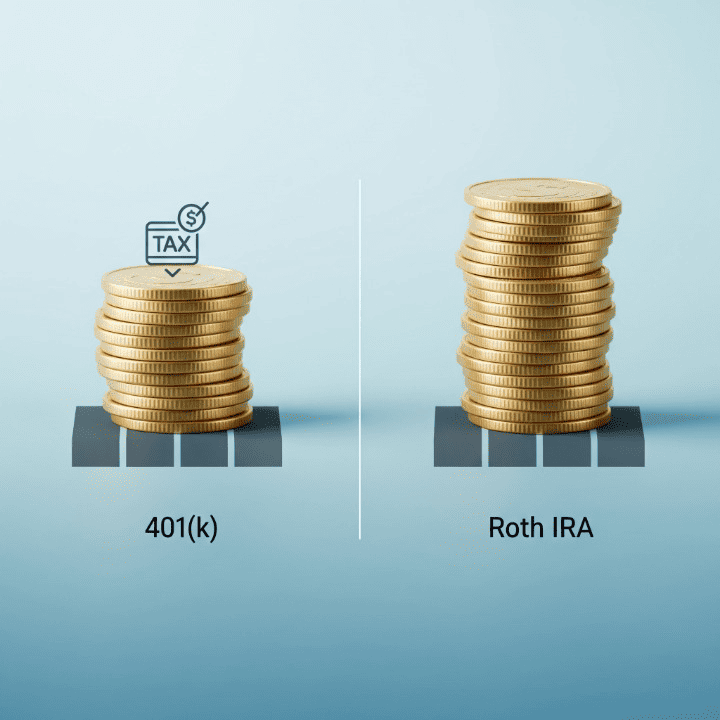
Introduction
Planning for retirement can feel like a daunting task. Many people know they need to save, but they get stuck trying to figure out which accounts to use. The choice between a 401(k) and a Roth IRA is one of the most common and important decisions you will face on your journey to financial freedom. These two accounts are powerful tools, but they work in fundamentally different ways. The decision you make today can have a significant impact on your taxes and your overall retirement nest egg decades from now. This comprehensive guide will demystify the 401(k) and the Roth IRA, explaining the key differences in their tax treatment, contribution limits, and flexibility. Our goal is to empower you with the knowledge to choose the best retirement vehicle for your specific situation and start building the future you envision.
The Foundation of Retirement Accounts: A Quick Overview
Before we dive into the specifics, it’s helpful to understand the basic concept of a tax-advantaged retirement account. These accounts encourage people to save for retirement by offering a special tax status. Your money grows over time, and you either pay taxes on your contributions now or on your withdrawals later. This difference in tax timing is the single most important distinction between a 401(k) and a Roth IRA. Understanding this concept is crucial for effective retirement planning.
Understanding the 401(k): A Powerful Employer-Sponsored Tool
A 401(k) is a retirement savings plan offered by an employer. It’s a fantastic tool because of its high contribution limits and the potential for a company match.
How a 401(k) Works
There are two types of 401(k) plans: Traditional and Roth.
- Traditional 401(k): You contribute pre-tax dollars. This means your contributions are deducted from your paycheck before taxes are calculated, which lowers your taxable income for the current year. Your money grows tax-deferred. When you withdraw the money in retirement, both your contributions and your investment earnings are taxed as ordinary income.
- Roth 401(k): You contribute after-tax dollars. Your money grows tax-free, and all withdrawals in retirement are completely tax-free, as long as you meet certain conditions.
Key Features and Benefits
- High Contribution Limits: For 2024, the contribution limit for a 401(k) is $23,000. People aged 50 and over can make an additional “catch-up” contribution of $7,500. This makes it an incredibly powerful tool for accumulating significant wealth.
- Employer Match: This is one of the biggest advantages of a 401(k). Many employers will match a portion of your contributions, often dollar-for-dollar up to a certain percentage of your salary (e.g., matching 100% of the first 3% of your salary you contribute). This is essentially free money and is a key reason why you should always contribute at least enough to get the full match.
- Ease of Use: Contributions are automatically deducted from your paycheck, which promotes a disciplined savings habit.
Key Drawbacks
- Limited Investment Options: You are limited to the investment options your employer offers, which are typically a handful of mutual funds or target-date funds.
- Less Control: You have less control over the account compared to an IRA. For example, you may not be able to roll it over to a different account until you leave your job.
- Withdrawal Restrictions: If you need to withdraw funds before age 59½, you will typically face a 10% penalty plus ordinary income tax on the amount.
Understanding the Roth IRA: A Flexible Individual Account
A Roth IRA (Individual Retirement Arrangement) is a personal retirement savings account that you can open on your own. It is known for its tax-free withdrawals in retirement and its flexibility.
How a Roth IRA Works
You fund a Roth IRA with after-tax money. This means you do not get an immediate tax deduction for your contributions. However, your money grows completely tax-free, and all qualified withdrawals in retirement are also tax-free.
Key Features and Benefits
- Tax-Free Withdrawals in Retirement: This is the primary benefit. If you expect to be in a higher tax bracket in retirement, a Roth IRA can be a great choice. You pay the taxes now and never have to worry about them again.
- Flexibility and Control: You can open a Roth IRA with any brokerage firm and choose from a huge range of investment options, including individual stocks, bonds, and ETFs.
- Contribution Flexibility: You can contribute to a Roth IRA at any time during the year, not just on a paycheck schedule.
- Penalty-Free Withdrawals: You can withdraw your contributions (but not the earnings) at any time without paying taxes or a penalty. This makes it a great emergency savings vehicle, as your principal is always accessible.
Key Drawbacks
- Contribution Limits: The annual contribution limit for a Roth IRA is much lower than for a 401(k). For 2024, the limit is $7,000 ($8,000 for those 50 and older).
- Income Limits: Not everyone can contribute to a Roth IRA. There are income limits that phase out your ability to contribute as your income rises.
- No Immediate Tax Deduction: You don’t get a tax break in the current year, which can be a turn-off for some savers.
The Big Question: Which One is Right for You?
Choosing between a 401(k) and a Roth IRA (or a combination of both) depends on your specific financial situation, age, and future expectations.
Choose a 401(k) If:
- Your employer offers a matching contribution. This is free money, and you should always contribute enough to get the full match first.
- You are in a high tax bracket now and expect to be in a lower tax bracket in retirement. The pre-tax contributions of a Traditional 401(k) will give you a valuable tax break today.
- You want to save more than the IRA contribution limits allow.
Choose a Roth IRA If:
- You are in a lower tax bracket now and expect to be in a higher one in retirement. Paying taxes now at a lower rate is a smart move.
- You value flexibility and want a wider range of investment options.
- You want the ability to access your contributions in an emergency without a penalty.
- You are a young professional just starting your career.
The Hybrid Approach: Using Both
Many financial experts recommend using both accounts. The optimal strategy is often to first contribute to your 401(k) to get the full employer match. This is your foundation. Next, max out a Roth IRA. The tax-free growth is an incredible benefit. Finally, if you still have money to save, go back to your 401(k) and contribute more, up to the annual limit. This “hybrid” approach gives you the best of both worlds: you get the free money from your employer, the flexibility and tax-free growth of a Roth IRA, and the ability to save a significant amount of money each year.
Conclusion
Planning for retirement is one of the most important aspects of sound financial planning. Understanding the difference between a 401(k) and a Roth IRA is a crucial step in this process. While a 401(k) is a powerful, high-limit tool often enhanced by an employer match, a Roth IRA offers incredible tax-free growth and flexibility. The choice ultimately depends on your personal circumstances, but for many, a combination of both accounts is the most effective strategy. By taking the time to understand these retirement savings vehicles, you can make informed decisions that will help you build a secure and prosperous future. Your future self will thank you for starting today.



